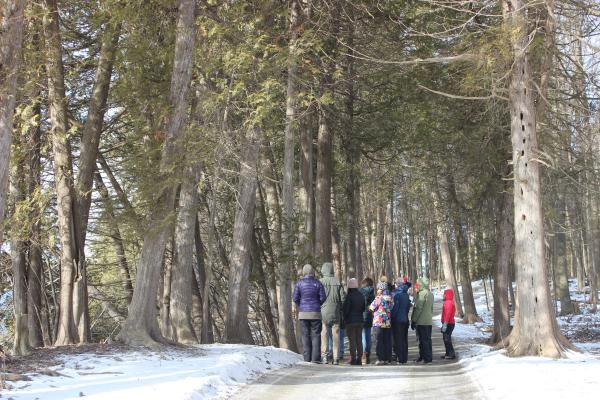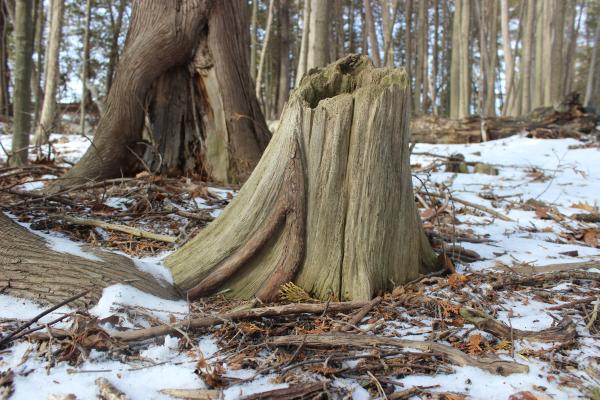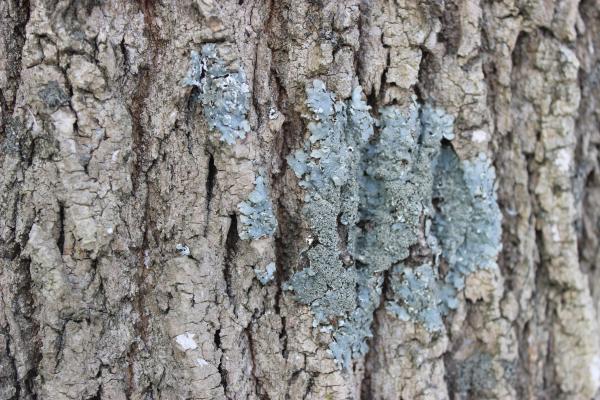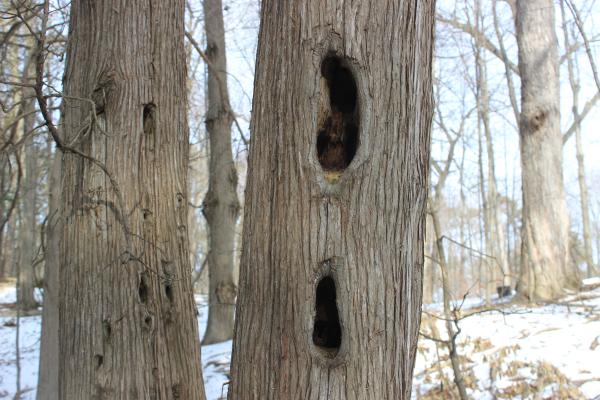Really loved this. Fascinating to learn about these cedars and found the living stumps especially intriguing. Thank you for posting this.
Secrets of our shoreline woods. A walk with Tom Wessels
If you’ve ever walked our trails to the lake, or enjoyed the Inn, you’ve probably noticed the distinctive shoreline bluffs. (You may have noticed the seawalls as well, built by workmen around 1900 at the behest of Farm founders William and Lila Webb. But that’s a story for another day.)
The bluffs overlooking Lake Champlain, both here and in many areas along the lake, are examples of a Limestone Bluff Cedar-Pine Forest. In late January, I tagged along with terrestrial ecologist Tom Wessels and more than a dozen teachers to explore a bit of this area.
The teachers were at Shelburne Farms for the winter session of a year-long program, Education for Sustainability Leadership Academy. The session explored the concept of adaptation in the wintry world, and how teachers might apply the lessons of “adaptation” to their leadership practice.
Their time with Tom was part natural history lesson, part conceptual dive into the idea that all living things evolve and adapt over time into “right relationships,” contributing to "self-organizing biological systems” that are resilient and stable.
Here are a few nuggets from the walk, as Tom explored various relationships in the natural world and the implications of this idea on our own relationships within natural and human systems.
Cedars grow along the lake’s edge
Others have detailed the elements of Limestone Bluff Cedar-Pine forests, pointing out that cedars like the shoreline’s alkaline -- if thin and rocky -- soils. Tom added that cedars also like moisture, and speculated that a lot of lake fog helps make this habitat good for cedars.
Twisted cedars and pines
Twisting bark is a widespread phenomenon among trees. But no one knows exactly why it happens and it has generated much theorizing. Tom suggests that a tree spirals to maximize photosynthesis. As a tree spirals, the leaves on its branches don't grow directly above the ones below, but are offset slightly to capture more sunlight. Spiraling may also help distribute water and nutrients more evenly around a tree. What is known, is that in harsh environmental conditions (high winds, extreme temperatures, etc.), a tree’s spiral will be tighter.
Curiously, according to Tom, about 90% of trees will twist counter-clockwise, 10% will twist clockwise -- at least in the northern hemisphere. Genetics determine the direction of the twist.
Also, more than likely, a twisted tree will be older than its trunk girth would suggest. (When determining the age of trees, you have to look at a lot more than size, says Tom.)
The wood-wide web
Although we’ve been taught to think that trees compete for sunlight, water, and nutrients, their underground root systems prove otherwise.
It turns out that trees growing within 15 feet of each other develop integrated, sometimes grafted root systems. Energy and nutrients go back and forth -- are shared -- between the trees, nurturing all. This can happen across tree species, with the largest trees in a forest having the most underground connections.
Mycorrhizal fungi make these connections possible. These fungi have evolved with tree roots to be co-dependent: The fungi colonize the roots and boost the tree's ability to absorb water and nutrients. In return, the tree “shares” energy (carbs) with the fungi. Beyond grafted root systems, these mycorrhizal networks create an integrated whole beneath the forest floor, or what Tom calls the “wood-wide web.”
To illustrate his point, Tom points to a living cedar stump. It looks dead, save for a forked, reddish ribbon of bark. (see photo) The stump is no longer generating energy (carbs) through leaf photosynthesis, but it is still receiving and using nutrients from the roots of neighboring trees to grow bark. Over time, its bark will grow over the top, seal off the hole, and remain a living stump.
“The idea that trees are competing is essentially wrong,” says Tom. “Are there integrated networks? Yes.”
Right relationships
Throughout our walk, Tom is intent on pointing out “right relationships:” tree to tree, lichen to tree, tree to woodpecker. Lichen lives happily on tree bark, for example, and gets its nutrients from the air. When it rains, the rain carries these nutrients straight down to the bottom of the tree, essentially fertilizing the tree.
Examining holes made by pileated woodpeckers, Tom points out that although the woodpecker damages a tree with these intrusions, it may also help the tree by eradicating one of the tree’s internal pests (and a pileated’s favorite food): carpenter ants.
Teacher take-aways
The idea of “right relationships” supporting stable and resilient systems was definitely resonating with the educators (a few side comments about marriages were made). The idea illustrated by the cedars was equally compelling: that integrated networks can sustain each “member” of an ecological community.
It made sense to me. “Integrated networks” is a powerful metaphor for how these educators are supporting each other in this program and creating the change they want to see in the world. And as they’re figuring out how to incorporate systems thinking into their curriculum, they’re also examining the complex systems that they’re working in--schools--and figuring out how to leverage change within them.
Some valuable guidance could come from nature. “Nature has figured it out,” Tom advises. “We don’t have to reinvent the wheel.”






